Menus
- What you must remember
- Themore
- Theless
- Prices
- Make your2016 Honda CRF 450 R
- Opinion
- Replaces
- The technical aspect
- Competitors
- Gallery
- Related articles
The flagship of the Cross Honda range announces a Ø 48 mm Kayaba PSF2 oleopneumatic fork revised in terms of its dimensions, the rigidity of its sleeves, the damping control and the adjustment range..
At the rear, the Kayaba mono-shock also benefits from new damping coefficients as well as additional adjustments.. Subtle changes in geometry echo the increased performance of the suspensions to optimize dynamic behavior, stability and ease of piloting. So many developments driven by the HRC competition program.
After having redefined the standards of behavior and perception of the front axle, the Ø 48 mm Kayaba PSF2 pneumatic fork benefits from several evolutions in order to optimize the dynamic behavior, the stability and the suspension tuning between the front and the front end. back.
Thus, the travel remains the same but the fork arms are now longer, with more rigid legs. The original compression and rebound settings are now firmer in order to maintain the best possible control at the end of the stroke while the adjustment possibilities are optimized.
Working in concert with a modified gear ratio Pro-Link system, the rear shock provides better rebound characteristics between the middle and end of its stroke. It also has a wide range of settings.
The evolutions brought to the suspensions as well as the desire to improve the behavior, the stability and the ease of use by the pilot have led to the application of subtle changes to the geometry of the steering. Further improvements include the design of the footrests as well as the final drive chain.
The 2015 CRF 450 R stood out for its more accessible power, improved traction at low revs and higher maximum power thanks to the modifications suggested by Team HRC A to the cylinder head, to the exhaust system and to the PGM-FI double injection. This same 2015 version also received the EMSB handlebar control system which offers the rider the choice between 3 engine maps, Standard, Soft or Dynamic. For 2016, the engine remains unchanged.
Cycle part
Weighing only 9.35 kg, the 6th generation of aluminum double beam frame was designed from the outset around the Kayaba PSF2s Ø 48 mm oil-pneumatic fork, more efficient than traditional spring-loaded forks and offering a real advantage in terms of grip from the front and liveliness in the pins.
In fact, the PSF2s offered real advantages, in particular during the phases of transition between compression and relaxation. Today, in order to improve both dynamic behavior, front / rear balance and stability, each of the left and right arms has been lengthened by 5 mm without the travel being affected (310 mm). The rigidity of the sliders has been increased in stages under the upper triple tree thanks to an increase in the diameter of the tubes from 53.5 to 54 mm.
In order to gain control during the landing phases of jumps or violent braking, the calibration of the damping force has been increased in compression as in rebound while the number of possible settings goes from 4 to 8 notches. All settings are now accessible directly at the top of the fork tubes, high / low speed compression on the left, high / low speed rebound on the right of each cap. The preload is adjustable via a Schrader type air valve.
At the rear, the KYB damper claims noticeably reduced compression as rebound is increased and the gear ratio of the Pro-Link system is changed as well. The shock absorber stroke is 133.5 mm for a travel of 315 mm at the wheel. Compression (high / low speed) and rebound adjustment devices are focused on the tank for easier access.
Changes to the fork length and gear ratio of the Pro-Link have led to a subtle change in the steering geometry. Thus, the caster angle goes from 27 ° 07 ‘to 27 ° 15’ with a drag increasing by 1 mm to 117 mm. The full weight remains unchanged at 110.6 kg.
Careful arrangement of equipment around the frame also contributes to mass centralization: all electrical components – electronic control unit, capacitor, regulator and electrical harness – are concentrated around the injector body.
The trim of the CRF 450 R 2016 renews the principle that the machine is built first and foremost around the rider and his requirements. In other words, ergonomics is at the heart of the layout offered by the CRF 450 R. Thus the radiator scoops, the side covers, the ultralight saddle or the fuel tank have a continuity of shape which gives the controls significant freedom of movement and fluidity of movement.
The markings and graphic details of the CRF reflect the colors of the factory machinery. Black radiator grilles are used for hard-to-reach places while the streamlined fuel delivery design (6.3 liter tank capacity) makes maintenance and cleaning easier.
Finally, slight improvements to the footrests and their supports make their locking in the high position much more difficult when mud accumulates there..
On the braking side, the Ø 260 mm “lace” front disc facilitates heat dissipation and improves the power generated by the action of the double piston caliper. The set is completed, at the rear, by a Ø 240 mm disc with a single piston caliper. The front fork and disc protectors retain a white color while the rear protectors remain in black.
The aluminum rims are fitted with Dunlop MX52F / MX52 tires of 80 / 100-21 for the front and 100 / 90-19 for the rear.
Made of aluminum, the rims (21 x 1.60 for the front, 19 x 2.15 for the rear) use specific spokes to reduce unsprung weight and are fitted with Dunlop MX52F / MX52 tires.
Motorization
The 2016 vintage of the CRF 450 R reproduces exactly the engine which already propelled the 2015 version. The sustained attention paid to this engine by the HRC resulted in improved power and torque values last year. speeds, by a more linear power curve At mid-speed and by an increased maximum power with also higher maximum speeds.
The characteristic dimensions of the water-cooled 4-stroke single cylinder remain fixed at 96 x 62.1 mm, with valves of 36 mm at the intake and 31 mm at the exhaust. The compression ratio is always 12.5 A 1 for a power of 53.7 hp at 9,000 rpm and a torque value of 5 mkg at 7,000 rpm.
What makes the CRF 450 R’s engine so usable and efficient isn’t just the way it delivers power and torque. The EMSB (Engine Mode Select Button) command is indeed what makes an already very available engine even more accessible. This system is an undeniable advantage for amateurs: rather than making adjustments during the week hoping that they will prove to be correct at the weekend, the pilot only has to stop, leave the engine idle and press the button for one second to select the engine map of your choice. Depending on the number of flashes observed on the light diode integrated in the handlebar control, the pilot can immediately know the mapping in progress. If a new map is selected, the choice is immediately confirmed by the same means.
In detail, Mode 1 uses a “standard” tuning between ignition and injection curves to provide balanced horsepower and torque characteristics. Mode 2 has been designed for low grip conditions – mud for example – and favors throttle control and fine feedback to allow the rider to make the most of the available grip. Finally, more particularly dedicated to sand, Mode 3 makes the engine more responsive and more aggressive in revs. Note that Modes 2 and 3 can be reprogrammed using the box as well as the software developed by the HRC.
Note that various maintenance kits will be available as an option for this 2016 vintage.
What you must remember
Themore
Theless
Prices
8 899 €
Price
nine
Compare
the credits
Make
your2016 Honda CRF 450 R
Estimate, calculate and compare the cost of insuring your motorcycle.
Calculate the cost of
insurance
Test the price of the motorcycle insurance specialist
Opinion
on 5 opinion
users
Read the reviews
Replaces

CRF 450 R 2015
Model marketed in
2011
2012
2013
2014
2015
2016
2017
2018
2019
2020
2021
The technical aspect
2016 Honda CRF 450 R
- Frame
- Frame: Double beam and single split aluminum cradle
- Tank: 6.3 liters
- Seat height: 955 mm
- Length: 2194 mm
- Width: 827 mm
- Height: 1,274 mm
- Wheelbase: 1494 mm
- Weight in running order: 110.6 kg
- Train before
- Telehydraulic inverted fork Ø 48 mm, deb: 310 mm
- 1 disc Ø 260 mm, 2 piston caliper
- Front wheel:
80/100
– 21
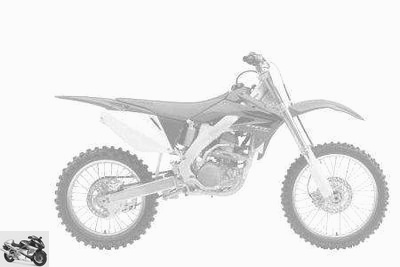
- Transmission
- 5-speed gearbox
- secondary by chain
- Rear axle
- Mono-shock absorber, deb: 315 mm
- 1 disc Ø 240 mm, 1 piston caliper
- Rear wheel:
100/90
– 19
- Motor
- Single cylinder
in line
, 4 stroke - Cooling: by water
- Injection Ø nc
- 1 ACT
- 4 valves
-
449.70 cc
(96 x 62.1 mm) -
54
ch
at 9000 rpm -
5 mkg
at 7,000 rpm - Compression: 12.5: 1
- Crit’air:
Detached pieces
exhaust
motor
fluid
electricity
filtration
braking
chain kit
Competitors
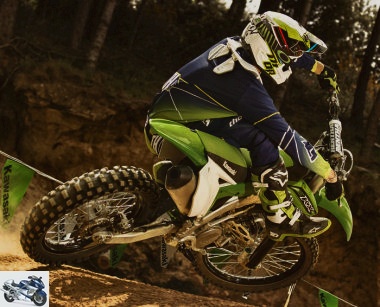
Kawasaki KX 450 F 2016
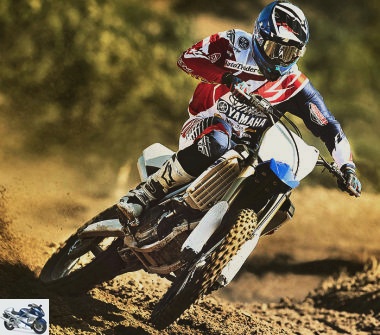
Yamaha YZ 450 F 2016
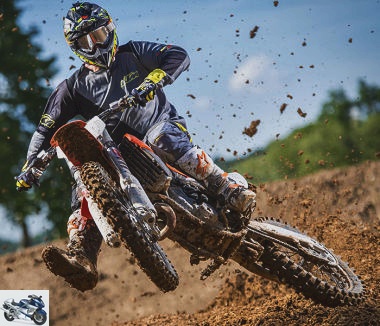
2016 KTM 450 SX-F
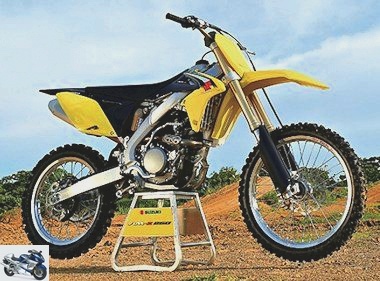
Suzuki RM-Z 450 2016
Gallery
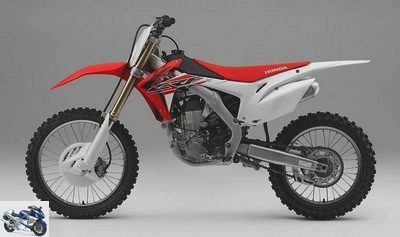
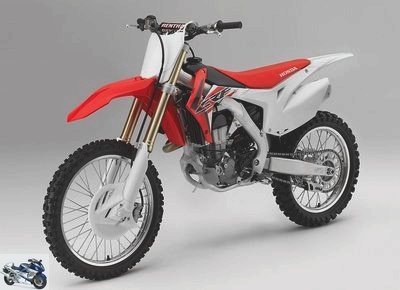
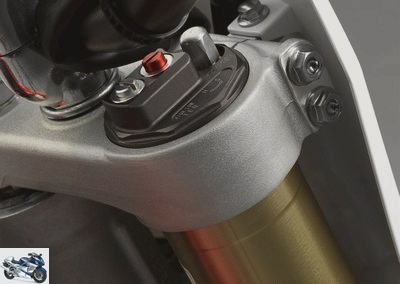
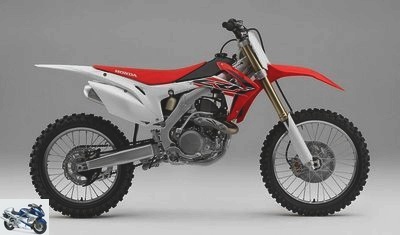
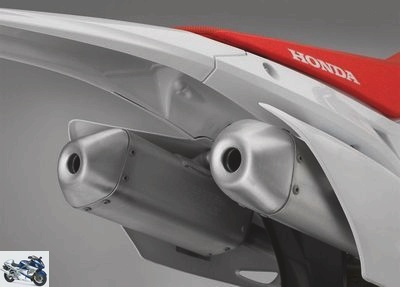
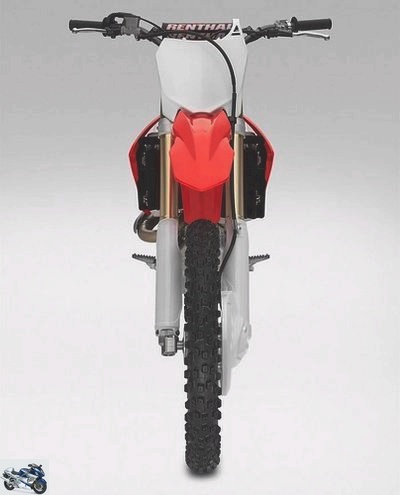
Related articles
-
Combining since 2002 a benchmark chassis with an engine overflowing with power and torque, the CRF 450 R has demonstrated its winning potential to…
-
If the CRF 250 R is already regularly illustrated on all cross-country circuits on the planet, the 2015 version takes a decisive step in several areas:…
-
In the two years since the radical redesign of the 2014 model – virtually every major function of the engine and chassis having been changed – the Yamaha…
-
No changes in 2016 for the Kawasaki KX 250 F. Modfis took place last year: in addition to its recognized performance in terms of engine and chassis, a…
-
The 450 CRF knows its potential and is committed to refining it. Torque and power values in the revs receive a serious boost while performance is…
-
The 2016 CRF 250 R claims a substantial gain in power at high revs thanks to the adoption of a new cylinder head, a new connecting rod and a new piston…
-
The YZ 250 only changes a piece of graphics (retouched decoration and black rims) for 2016. The cross-country machine had benefited in 2015 from a…
-
For its 2021 vintage, the Honda CRF 450 R benefits from a long list of improvements. To begin with, 2kg have been gained on the frame and the rear loop….
-
Honda did a hell of a job on their cross-country machine. Faced with very sharp competition, the 250 CRF had to evolve and the result is there: it…
-
After its slight facelift in 2011, the big Honda streetfighter continues its career nicely. The CB 1000 R “phase 2” could not be closer to the previous…